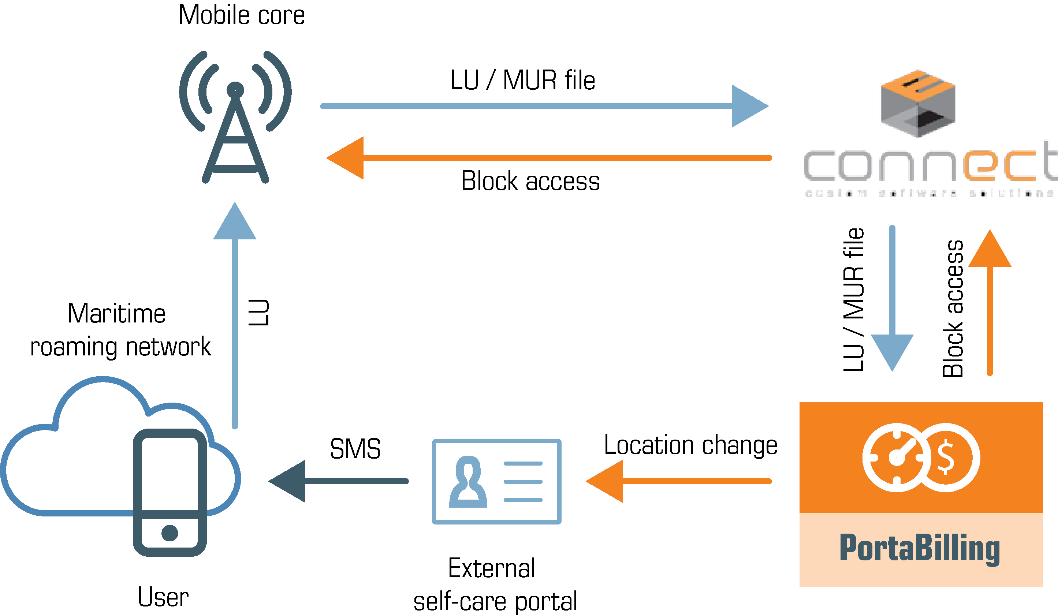PortaBilling is integrated with the ECConnect Access Portal (EAP) platform – the provisioning solution for MVNOs, which operate on the Optus network in Australia.
PortaBilling provisions the ECConnect EAP via the ESPF (External System Provisioning Framework) with the following data:
- SIM card details (ICCID);
- subscriber details (MSISDN, service configuration, billing status);
- ECConnect-related information such as "phoneid" and "clientid." These are the unique IDs of a subscriber’s record and phone number in the ECConnect EAP;
- subscriber location details to control their Internet access in the roaming networks.
ECConnect EAP then provisions the Optus mobile core to activate the SIM and grant access to the services for your mobile subscribers.
This is how it works:
Your administrator uploads SIM cards and configures their rate plans and mobile service profiles in the ECConnect EAP. The rate plans must match the PortaBilling products.
In PortaBilling the administrator does the following:
- configures products that correspond to the rate plans defined in the ECConnect EAP (e.g., domestic and roaming ones) and enables the Mobile network provisioning service to trigger provisioning;
- uploads SIM cards;
- configures custom fields for customer and account records to store ECConnect-related information such as "clientid" and "phoneid," and
- configures the ESPF to provision subscriber data.
When John Doe signs up for the mobile service bundle, a new customer is created in PortaBilling and a SIM card is assigned to this customer’s account. PortaBilling sends a provisioning request with SIM card details and subscriber data to ECConnect EAP. ECConnect EAP processes the request and generates the "phoneid" and "clientid" values for the subscriber. Then ECConnect EAP triggers the API call to the Optus mobile core to activate the SIM card. John Doe can now enjoy the service.
Whenever John’s account status changes in PortaBilling (e.g., he runs out of funds or his account is suspended), PortaBilling updates the Optus mobile core via the ECConnect to stop John’s services until he tops up the balance. The provisioning request now includes the "phoneid" and "clientid" values to update the service availability status for John in the Optus mobile core.
If John decides to update his phone number with a different one or change his SIM card, his new details update automatically in the Optus mobile core without his service being stopped. This ensures the data integrity in the entire network infrastructure.
Location-based control of Internet access
Roaming users can connect to networks where mobile data usage is extremely expensive, e.g., on board a cruise ship or in an airplane. To prevent users from high overdraft and bill shock, MVNOs can block Internet access to roaming users when their location changes to Aerospace or Maritime.
This is how it works: User location information can be obtained from the LU (Location Update) and MUR (Mediated Usage Records) files. LU files are created when a user’s phone registers on a roaming network. The mobile core receives the LU file and sends it to PortaBilling via the ECConnect Access Portal (EAP). However, LU files can become delayed or even get lost. Therefore, MUR files are also used to identify a user’s location. The mobile core generates MUR files when a user starts the Internet session and it sends them to PortaBilling via the ECConnect EAP. MUR files are sent every 15 minutes, which speeds up user location identification.
PortaBilling reads the LU/MUR files and updates a user’s location using the xDR mediation utility. A user’s location and the date and time of its change are stored in custom fields for the user’s account in PortaBilling. If a user is located in the expensive zone identified as AEROSPACE or MARITIME, PortaBilling sends the provisioning request to the mobile core via the ECConnect EAP to block Internet access to them. However, SMS and voice call services remain available.
To notify a user about their location change and applicable rates for service usage, PortaBilling communicates with the external self-care portal. PortaBilling provisions the user’s location to the external self-care portal, which sends an SMS notification to the user.
A user can manually unblock Internet service via the external self-care portal. In this case, the self-care portal updates the user’s location in PortaBilling via the API. PortaBilling then provisions the mobile core via the ECConnect EAP to unblock Internet access for the user.
To control Internet access based on user location, do the following:
- Create the custom fields for the account record (e.g., "location" and "timestamp") to store the user’s location and the date and time of the last location change in PortaBilling.
- In the ESPF handler config file, specify which locations to block Internet service for by default (e.g., AEROSPACE OR MARITIME) in the [RestrictedLocations] section.
- Configure the xDR mediator to read the LU/MUR files and update the user’s location. Please contact PortaOne support if you want assistance.
- Build or adjust your external self-care portal to communicate with PortaBilling.
This integration is useful for Australian CSPs interested in becoming MVNO. It provides a ready-to-use solution to roll out services virtually instantly and therefore become an active player in the telecommunications market.



